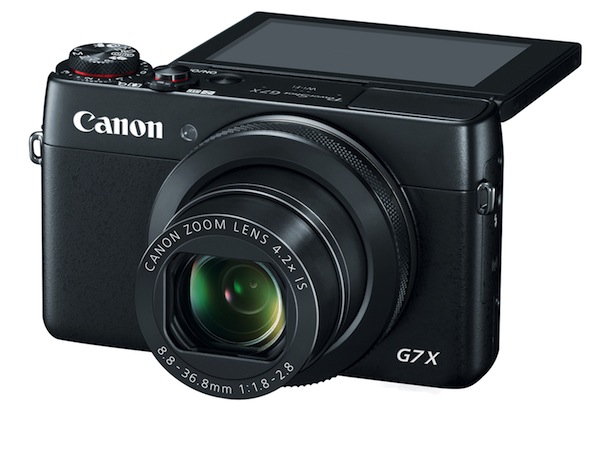Canon G7 X Super Pocket Cam Challenges Sony RX 100 III
Canon goes head-to-head with Sony's RX100 III in the battle of the high-performance pocket cameras with 1-inch sensors.

The megapixel wars might be over (sort of) but the battle of the sensor size is in full swing, particularly when it comes to compact cameras. Now, with the introduction of the 20 megapixel, $700 PowerShot G7 X (expected to go on sale in October), Canon has—for the first time—released a compact camera with a 1-inch sensor that allows it to offer higher performance than your standard point-and-shoot. I got some hands-on with this new model and was impressed with its solid build, petite dimensions and ease of operation.
It's just half the size of the Canon PowerShot GX 1’s 1.5-inch sensor, but if Sony's 1-inch sensor-bearing RX100 III (read review) is any indication, a 1-inch sensor can deliver surprisingly good performance. (In fact, a sensor that size is also used in the respected Nikon mirrorless camera line, such as the new Nikon 1 J4 (read review) as well as Samsung's NX Mini.) Among the benefits Canon touts is better low-light performance. Part of Canon’s HS (high sensitivity) line, the G7 X offers an ISO range of 125-12,800. It’s not the broadest ISO range among compact cameras, but it covers most low-light conditions, assuming the quality is respectable.
MORE: New Fixed-lens Cameras Challenge DSLRs and Mirrorless
Up to full 1080p HD video capture at 60fps is possible. And the touchscreen controls should make made shooting video — and focusing — very easy. The flip up LCD comes in handy for video shooting as well.
Easy to use
The G7 X is very compact at 4.1 x 2.4 x 1.6 inches, and has a nice feel to it. It's equipped with a newly developed 4.2x optical zoom lens, with an equivalent focal range of 24-100mm. The lens's f/1.8 (wide) to f/2.8 (telephoto) aperture range is plenty large to let in lots of light for shooting in dim conditions — and for creating artsy shallow depth of field effects.
Manual, automatic and semi-automatic exposure modes cover all bases, regardless of experience levels. The control ring that surrounds the lens can be set to control either shutter speed or aperture settings.
Designed to make the selfie-set smile, the G7 X’s 3-inch LCD can be flipped up 180 degrees. A quick tap of the touchscreen triggers the shutter. And with the camera’s built-in Wi-Fi, images can be shared via iOS and Android mobile devices.
Sign up to get the BEST of Tom's Guide direct to your inbox.
Get instant access to breaking news, the hottest reviews, great deals and helpful tips.
MORE: A Digital Camera Glossary
Other features of note include a selection of options within the Star Mode. These are designed to photograph the night sky, including star trails and time-lapse movies of heavenly bodies. For more creative options, the G7 X is equipped with a number of effects filters as well.
The battle of the mini cameras is heating up. The G7 X's immediate competitor is the high-performance Sony RX100 III, another pocket-sized camera with a 1-inch sensor. But the G7 X will also go up against a new fleet of somewhat larger, giant-sensor cameras, such as the just-announced Panasonic LX100.
- Best DSLR Cameras 2014
- How Many Megapixels Do You Really Need?
- DSLR vs. Mirrorless Cameras: Which Is Better for You?
Writer and photographer Theano Nikitas has been covering photography for almost 20 years and has reviewed hundreds of digital cameras as well as other digital imaging hardware and software. Follow her @TNikitas1 and on Google+. Follow us @TomsGuide, on Facebook and on Google+.
Theano Nikitas is a freelance journalist and photographer. She's been writing about photography for more than 20 years, contributing countless reviews of cameras, lenses, accessories and software packages to Tom's Guide. Her work has also appeared in dozens of other magazines and websites, including CNET, DPreview, PopPhoto, Professional Photographer and Shutterbug.
